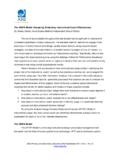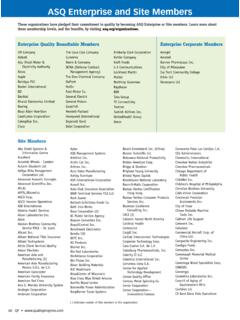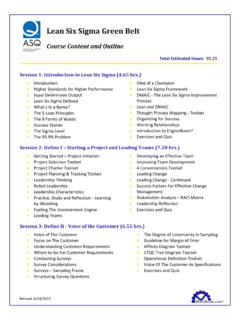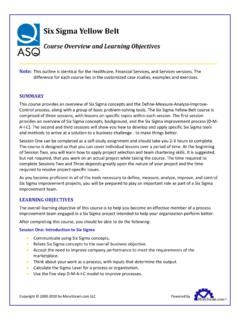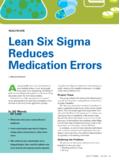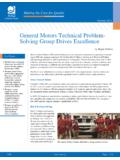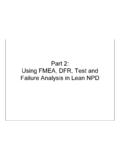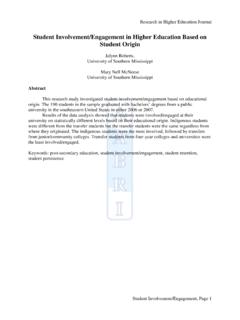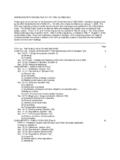Transcription of The Business Case for Lean Six Sigma in Higher Education
1 1 ASQ Higher Education Brief Vo. 6, No. 3 May 2013 The Business case for lean Six Sigma in Higher Education by Norma Simons At the Time Summit on Higher Education in October 2012, Arne Duncan, the secretary of Education , indicated that Higher Education is at a crossroads and identified a few key challenges facing the Education system: The high price of college tuition. Low college completion rates. Little accountability when it comes to improving attainment and achievement. When discussing the Higher Education system, there is a tendency to focus only on the quality of graduates and their ability to function in the workplace. While this is critical, we also need to look at Education as a total collaborative system that requires involvement from all areas of the institution.
2 In his book The New Economics: For Industry, Government, Education , W. Edwards Deming stated that the Education system can be improved by using the same principles that are used to improve processes and systems in other To improve Higher Education , both academic and nonacademic processes must be identified, improved and aligned with performance and cost objectives. All processes must demonstrate their efficiency and effectiveness. lean Six Sigma (LSS) is a method that helps organizations gain a competitive advantage by becoming faster, better and more cost effective. lean helps identify and remove waste and improve the overall efficiency and speed in which a service is delivered.
3 Six Sigma helps identify and prevent errors and ensure that processes are able to deliver outputs that meet customer requirements. lean and Six Sigma are complementary and provide organizations with a set of tools for management and Higher Education needs a method that supports a systems-thinking and project-based approach for improvement. Key themes2 of LSS include: A strong focus on the internal and external customer. Use of clearly defined processes. Data-driven decision making. Cross-functional collaboration. 2 ASQ Higher Education Brief Vo. 6, No. 3 May 2013 Total employee involvement. The use of structured problem-solving skills.
4 Strong leadership understanding and commitment. Benefits of LSS in Higher Education It is evident the Education system wrestles with the need to become cost effective and, at the same time, deliver top-performing students. The following is a list of some of the proven benefits of using LSS in Higher Education : 1. Meet accreditation requirements. LSS provides a system that enables colleges to meet accreditation requirements. Some institutions are required to submit three action projects each year as a part of the requirements for the Academic Quality Improvement. Program (AQIP) to maintain their accreditation status with the Higher Learning Commission.
5 2. Provides a template for problem solving. The define, measure, analyze, improve and control (DMAIC) process provides a template for problem solving, root cause analysis (RCA) and continuous improvement. In Education , most individuals are not familiar with the use of a systematic process for problem solving and RCA. DMAIC provides a roadmap to achieve project objectives. 3. Promotes total involvement. Multiple functions and departments within the institution are involved in applying the quality concepts based on the project selected. This fosters collaboration across the functional silos and provides a means to effectively communicate and resolve problems.
6 4. Help establish measures. Measures used in Education tend to be lagging indicators. Because of the requirements of LSS, team members identify leading indicators that reflect the success of projects. 5. Make processes visible. LSS encourages teams to make processes visible using tools such as the supplier, inputs, process, outputs and customer diagram, value stream maps and process maps. Once processes are visible, teams can identify and remove waste. 6. Obtain information on the voice of the internal and external customer. In most educational environments, the concept of the customer is only applied to students. However, LSS requires that all stakeholders are considered and that their requirements are included in process design.
7 In LSS, the customer is defined as any individual or department that receives information or an output from another individual or department. 7. Identify and reduce hidden costs. There are several costs that are hidden in Higher Education . This concept is often referred to as the hidden factory. These costs consume 3 ASQ Higher Education Brief Vo. 6, No. 3 May 2013 resources, people and time, and add very little to customer requirements. In many cases, this can result in the drive to achieve a goal with little attention paid to the process of achieving the goal. Description of LSS in Higher Education Two colleges in Michigan have embraced the concepts of LSS and have found tremendous value in using the method to identify and solve major problems.
8 At these schools, LSS has been introduced as a customized Green Belt program. In each case , the program was delivered to the executive group the president and other key decision makers. Several other groups were trained 60 individuals and 40 individuals at each organization, respectively. Each training program involved: Project selection. The organization developed a method for selecting projects that had significant impact on the strategic plan. Every project required the development of a Business case and was often selected because it caused pain points for areas of the organization or was regarded as a burning platform something critical to its survival.
9 Team selection. Cross-functional teams were selected for LSS training. In each case , the individuals selected were those who either had leadership positions or were being considered in the leadership development process. In most cases, additional personnel were added to the core teams to help with projects. This exposed other individuals who were not a part of the training program to the LSS philosophy. Customized training in LSS. A curriculum for Higher Education was developed and delivered either onsite or using the blended learning approach. Participants attended training sessions with a project already selected and were given assignments between each session to apply LSS.
10 Table 1 shows a list of the tools and techniques discussed at each phase of the DMAIC process. Project consultation. Between training sessions, coaches met with teams to provide assistance and guidance in applying some of the tools. Project management discipline. Teams followed a project management discipline which required gate reviews and sign-offs, a clearly defined project scope, a Business case , a problem statement and a project charter. At the end of the program, each team was required to present a documented report and a presentation to senior leaders at the organization. Teams were not only introduced to the tools and techniques associated with the method, but also to its structure.
